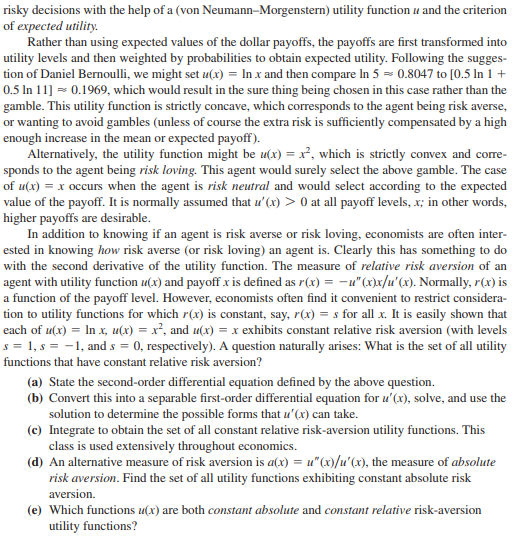

Would you rather have $5 with certainty or a gamble involving a 50% chance of receiving $1 and a 50% chance of receiving $11? The gamble has a higher expected value ($6); however, it also has a greater level of risk. Economists model the behavior of consumers or other agents facing risky decisions with the help of a (von Neumann-Morgenstern) utility function and the criterion of expected utility Rather than using expected values of the dollar payoffs, the payoffs are first transformed into utility levels and then weighted by probabilities to obtain expected utility. Following the sugges- tion of Daniel Bernoulli, we might set u(x) = In x and then compare In 5 = 0.8047 to [0.5 In 1 + 0.5 In 1] -0.1969, which would result in the sure thing being chosen in this case rather than the gamble. This utility function is strictly concave, which corresponds to the agent being risk averse, or wanting to avoid gambles (unless of course the extra risk is sufficiently compensated by a high enough increase in the mean or expected payoff). Alternatively, the utility function might be u(x) = x, which is strictly convex and corre- sponds to the agent being risk loving. This agent would surely select the above gamble. The case of u(x) = x occurs when the agent is risk neutral and would select according to the expected value of the payoff. It is normally assumed that '(x) > 0 at all payoff levels, x; in other words, higher payoffs are desirable. In addition to knowing if an agent is risk averse or risk loving, economists are often inter- ested in knowing how risk averse (or risk loving) an agent is. Clearly this has something to do with the second derivative of the utility function. The measure of relative risk aversion of an agent with utility function (x) and payoff x is defined as r(x) = -u"(x)x/u'(x). Normally, r(x) is a function of the payoff level. However, economists often find it convenient to restrict considera- tion to utility functions for which r(x) is constant, say, r(x) = s for all x. It is easily shown that each of u(x) = In x, u(x) = x, and (x) = x exhibits constant relative risk aversion (with levels s = 1, s = -1, and s = 0, respectively). A question naturally arises: What is the set of all utility functions that have constant relative risk aversion? (a) State the second-order differential equation defined by the above question. (b) Convert this into a separable first-order differential equation for u'(x), solve, and use the solution to determine the possible forms that u'(x) can take. (c) Integrate to obtain the set of all constant relative risk-aversion utility functions. This class is used extensively throughout economics (d) An alternative measure of risk aversion is a(x) = u(x)/u'(x), the measure of absolute risk aversion. Find the set of all utility functions exhibiting constant absolute risk aversion. (e) Which functions (x) are both constant absolute and constant relative risk-aversion utility functions? Would you rather have $5 with certainty or a gamble involving a 50% chance of receiving $1 and a 50% chance of receiving $11? The gamble has a higher expected value ($6); however, it also has a greater level of risk. Economists model the behavior of consumers or other agents facing risky decisions with the help of a (von Neumann-Morgenstern) utility function and the criterion of expected utility Rather than using expected values of the dollar payoffs, the payoffs are first transformed into utility levels and then weighted by probabilities to obtain expected utility. Following the sugges- tion of Daniel Bernoulli, we might set u(x) = In x and then compare In 5 = 0.8047 to [0.5 In 1 + 0.5 In 1] -0.1969, which would result in the sure thing being chosen in this case rather than the gamble. This utility function is strictly concave, which corresponds to the agent being risk averse, or wanting to avoid gambles (unless of course the extra risk is sufficiently compensated by a high enough increase in the mean or expected payoff). Alternatively, the utility function might be u(x) = x, which is strictly convex and corre- sponds to the agent being risk loving. This agent would surely select the above gamble. The case of u(x) = x occurs when the agent is risk neutral and would select according to the expected value of the payoff. It is normally assumed that '(x) > 0 at all payoff levels, x; in other words, higher payoffs are desirable. In addition to knowing if an agent is risk averse or risk loving, economists are often inter- ested in knowing how risk averse (or risk loving) an agent is. Clearly this has something to do with the second derivative of the utility function. The measure of relative risk aversion of an agent with utility function (x) and payoff x is defined as r(x) = -u"(x)x/u'(x). Normally, r(x) is a function of the payoff level. However, economists often find it convenient to restrict considera- tion to utility functions for which r(x) is constant, say, r(x) = s for all x. It is easily shown that each of u(x) = In x, u(x) = x, and (x) = x exhibits constant relative risk aversion (with levels s = 1, s = -1, and s = 0, respectively). A question naturally arises: What is the set of all utility functions that have constant relative risk aversion? (a) State the second-order differential equation defined by the above question. (b) Convert this into a separable first-order differential equation for u'(x), solve, and use the solution to determine the possible forms that u'(x) can take. (c) Integrate to obtain the set of all constant relative risk-aversion utility functions. This class is used extensively throughout economics (d) An alternative measure of risk aversion is a(x) = u(x)/u'(x), the measure of absolute risk aversion. Find the set of all utility functions exhibiting constant absolute risk aversion. (e) Which functions (x) are both constant absolute and constant relative risk-aversion utility functions








